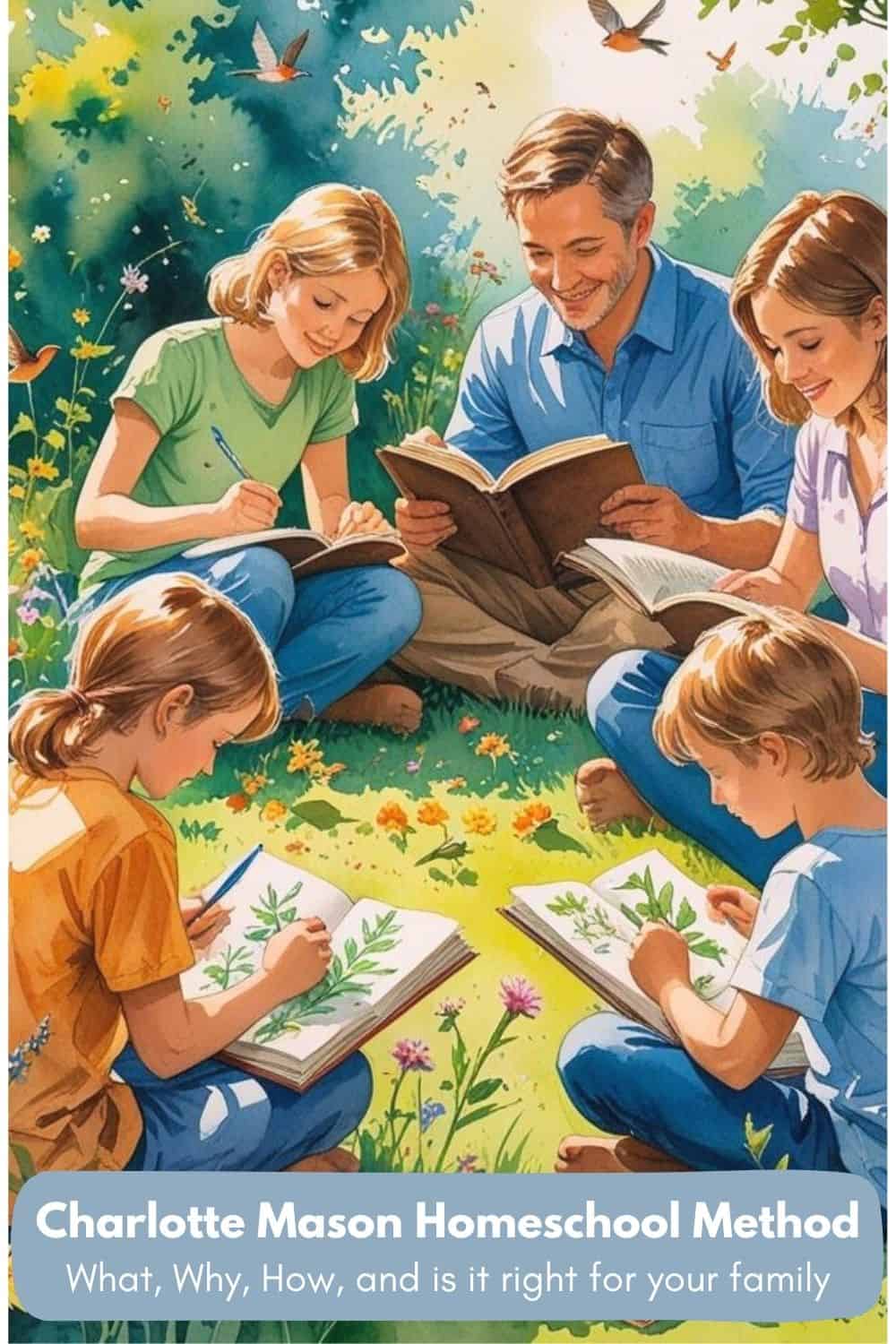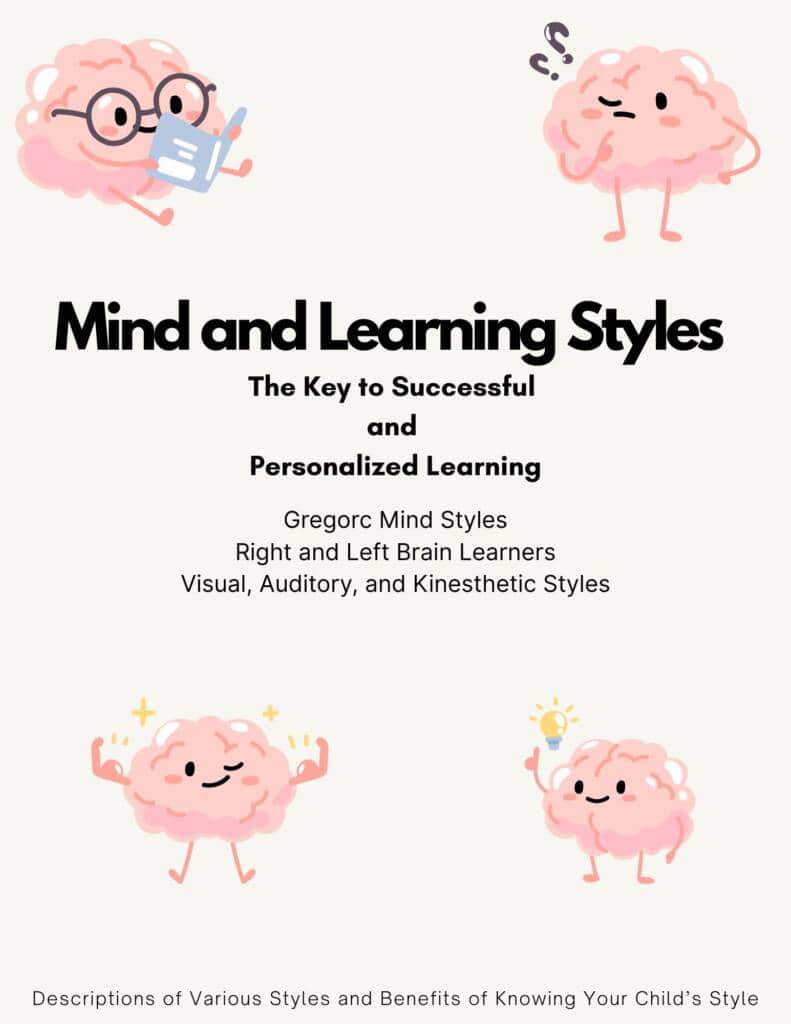This post about the Charlotte Mason Homeschool Method is the second post in a 10 part series about different homeschooling methods.
This series includes the following homeschooling methods:
- Classical Homeschool
- Charlotte Mason
- Montessori
- Unschooling
- Traditional or School at Home
- Project Based Learning
- Eclectic or Mixed Approach
- Unit Studies or Thematic
- Delight Directed or Interest Led Learning
- Waldorf
Embracing the Charlotte Mason Method: A Gentle and Beautiful Approach to Homeschooling
When you picture your ideal homeschool day, what do you see? Is it a quiet morning with rich stories, leisurely nature walks in the afternoon sun, and thoughtful conversations around the dinner table?
If so, you might be drawn to the Charlotte Mason method—a gentle, literature-rich, and natural approach that nurtures not only the mind but also the heart and soul of a child.
The Charlotte Mason Homeschool method is more than just an educational philosophy—it’s a lifestyle centered on nourishing a love for learning, building strong character, and fostering wonder in the world around us.
If you’re exploring homeschool options and yearning for something meaningful, flexible, and inspiring, this method may be the answer you’ve been looking for and matches your child’s learning style.
Who Was Charlotte Mason?
Charlotte Mason (1842–1923) was a British educator who believed that children are born persons—whole, capable individuals worthy of respect and intellectual nourishment from the very beginning. She was a pioneer in educational reform, advocating for high-quality, life-enriching education for all children, regardless of social class.
Her methods, “a natural, child-centered approach that emphasizes living books, nature study, art, and a broad curriculum to cultivate a love of learning and self-directed exploration” offer a refreshing alternative to rigid, test-focused models. Today, homeschool families across the world are rediscovering the power and peace of Charlotte Mason’s gentle, yet rigorous, approach.
Core Principles of the Charlotte Mason Method
The Charlotte Mason philosophy is built around several key ideas that form the heart of her educational model:
- Education is an atmosphere, a discipline, a life.
- Children are born persons.
- The best education feeds both the mind and the spirit.
- Short, focused lessons are more effective than long, tedious ones.
- Living books—not dry textbooks—bring knowledge to life.
- Nature study fosters attention, wonder, and a love for creation.
- Narration helps students process and retain what they learn. (This was one of the most effective homeschooling methods in our homeschool for many reasons.)
- Habit training is as essential as academic instruction.
Let’s take a closer look at how these ideas are practiced in a homeschool day.
The Charlotte Mason Approach in Action
1. Short Lessons That Respect a Child’s Attention Span
Charlotte Mason believed in short, focused lessons—typically 15 to 20 minutes for younger children and gradually increasing for older students. The goal is not to rush learning, but to to keep in mind a child’s capacity for attention and learning and avoid mental fatigue.
This approach allows time for more subjects in a day without overwhelming the child. It also leaves plenty of space for outdoor play, reading, and creative pursuits. This was invaluable with two young wiggly boys!
2. Living Books: Literature That Breathes Life Into Learning
One of the highlights of the Charlotte Mason Homeschool method is the use of living books—well-written, engaging works by authors who are passionate and knowledgeable about their subjects. (Learn more about the use of living books in your homeschool.)
Unlike dry, fact-based textbooks, living books draw the reader into a story, evoke emotion, and ignite curiosity. (These are great books for those children with learning styles that thrive on making emotional connections to their material they are learning. More about this below in my resource about children’s learning and thinking styles.)
Children don’t just memorize facts about Ancient Rome—they read tales of real historical figures, explore myths, and listen to the voices of those who lived it. This method builds both knowledge, empathy, and a meaningful connection for the child, which helps in memory retention.
Living books are used in nearly every subject: history, science, geography, literature, and even math. Rather than spoon-feeding information, they invite the child into a relationship with knowledge making that knowledge their own.
3. Narration: Retelling Builds Understanding
Instead of worksheets and multiple-choice quizzes, the Charlotte Mason method uses narration—asking a child to retell, in their own words, what they’ve just read or heard. (Learn more about the benefits of narration.)
Narration can be oral or written and helps develop comprehension, memory, and communication skills. Over time, it encourages children to become articulate thinkers and expressive writers.
Narration isn’t about reciting facts—it’s about making connections, reflecting on ideas, and internalizing knowledge.
After practicing narration, our family took the next step in writing about what my children narrated after we finished reading aloud together. We would use notebooking pages like these with themes, various line spacing, and images similar to these in this bundle –

4. Nature Study: Building a Relationship With Creation
One of the key and unique features of the Charlotte Mason method is nature study. Charlotte believed that regular time outdoors was essential for a child’s physical health, mental clarity, and spiritual well-being. (Learn more about nature study and how you can study science through nature study.)
To get you started with nature study you will want to use our Nature Study, Nature Journals, and Poetry Through the Year ebook with guidance and resources to conduct your own nature studies every month and for each season.

Children are encouraged to:
- Take daily nature walks
- Observe plants, animals, and seasonal changes
- Keep a nature journal with drawings, notes, and poetry
- Develop the habit of attention and appreciation for the world around them
This hands-on, observational science fosters not only curiosity but also reverence for creation and a sense of stewardship for the natural world, while also seeing how creation works together.
5. Habit Training: Shaping the Whole Person
Charlotte Mason saw education as the formation of character, not just the transmission of knowledge. A significant part of her philosophy involves habit training—the intentional development of good habits in areas like attention, obedience, order, truthfulness, and kindness.
Habits are gently cultivated through consistency, example, and encouragement. Rather than nagging or punishing, parents guide children toward self-discipline and good morals.
This focus on habits provides a solid foundation not only for academic success but for a well-lived life.
6. Rich Exposure to the Arts
The Charlotte Mason method weaves art, music, and poetry seamlessly into daily life. Children are exposed to masterpieces—not watered-down versions—so they can learn to appreciate beauty and greatness.
Some practices include:
- Picture study: Looking at and discussing works of art by famous painters
- Composer study: Listening to and learning about the lives of great composers
- Poetry reading: Memorizing and reciting classic poems
- Handicrafts: Developing fine motor skills and patience through meaningful, practical projects like knitting, woodworking, or embroidery
Art is not treated as fluff—it’s seen as a vital part of the child’s intellectual and emotional development.
What a Charlotte Mason Homeschool Day Might Look Like
One of the beauties of this method is its flexibility. A Charlotte Mason Homeschool day might vary depending on age, but here’s a general glimpse:
Morning:
- Bible reading and discussion
- Poetry or hymn study
- Short lessons: math, copywork, spelling, reading from living books
- Narration after each reading
Late Morning:
- Outdoor time or nature walk
- Nature journaling or sketching
- Picture study or music appreciation
Afternoon:
- Handicrafts, drawing, or free play
- Read-aloud from a classic novel or historical biography
- Quiet rest time or independent reading
Rather than packing the day with busywork, this relaxed routine balances academic discipline with rest, exploration, and beauty.
Why Families Love the Charlotte Mason Method
Homeschool families are drawn to Charlotte Mason Homeschooling for many reasons:
1. It Cultivates a Lifelong Love of Learning
By focusing on rich, engaging materials and giving space for curiosity, children develop a genuine passion for discovery and self-education.
We predominantly used a Charlotte Mason inspired method in our homeschool and my guys thrived and loved learning. It gave them the passion and curiosity to learn on their own as they grew older and definitely has helped them in college and their post graduate careers where they have had to learn on their own.
2. It Honors the Whole Child
This method respects children as individuals—emotionally, intellectually, and spiritually. It allows them to grow at their own pace, in harmony with their natural development.
3. It Builds Strong Relationships
The slower, more intentional pace of a Charlotte Mason day invites connection—through shared reading, family discussions, and time in nature. It creates a calm, relational homeschool environment.
One of the biggest highlights of our days and my guys still comment on it was the reading together as a family and our nature hikes.
4. It Encourages Independent Thinking
Through narration, habit training, and exposure to great ideas, children learn to think critically, express themselves clearly, and develop their own opinions.
5. It Creates a Home Culture of Beauty and Wisdom
With music, poetry, literature, and nature at its heart, the Charlotte Mason method nurtures an appreciation for the arts and how it fits into our world and of God’s creation all around us.
Is the Charlotte Mason Homeschool Method Right for You?
Charlotte Mason homeschooling can be a wonderful fit for families who:
- Love books, storytelling, and literature-based learning
- Want a gentle, yet intellectually rich homeschool experience
- Value nature and outdoor exploration
- Prefer a relationship-driven and character-focused education
- Appreciate the arts and want them integrated into everyday life
- Seek flexibility and freedom without sacrificing academic quality
That said, this method does require focus and preparation by the parent, especially in selecting quality materials.
It may not appeal to those looking for a strictly test-prep, prepared and structured style. But for many families, the payoff in joy, connection, and deep learning is well worth the effort.
How do I know if the Charlotte Mason Homeschool Method is right for my child?
Here is a resource I created to assist you in determining your child’s learning and thinking styles with assessments and descriptions and which homeschool method and curriculum is the right for one for them. You will find descriptions of various learning and thinking styles, assessments to determine your child’s styles, suggested teaching methods, materials, and curriculum with links for you to consider that match your child’s styles.

How to Start a Charlotte Mason Homeschool
Ready to do a little research to learn about the Charlotte Mason Homeschool Method? Here are a few steps to help you get started:
1. Read the Foundational Works (I loved these books!)
Great starting points include:
- For the Children’s Sake by Susan Schaeffer Macaulay
- A Charlotte Mason Companion by Karen Andreola
- Consider This by Karen Glass
- Home Education (Charlotte Mason’s original writings, Volume 1)
2. Explore Charlotte Mason Curriculum Options
Some well-loved programs include:
- Ambleside Online (free, robust curriculum based on Mason’s original work)
- A Gentle Feast
- Simply Charlotte Mason
- Living Books Curriculum
3. Begin with Living Books and Nature Walks
Don’t worry about doing everything perfectly. Start with reading aloud, narration, and outdoor exploration. Let your homeschool evolve naturally.
Just starting with this habit several times per week sets the foundation for adding other aspects of this method and building a full routine.
4. Join a Community
Many areas have Charlotte Mason groups or co-ops. Online communities are also rich with support, resources, and encouragement.
Or, just joining a co-op with some enrichment activities that pertain to art, music, literature, or handicrafts will add to your Charlotte Mason homeschool.
To help you get started with the Charlotte Mason homeschool method, this Audio Workshop set is helpful. It included directions and examples of how to use the Charlotte Mason method in an inspired way if you want to include other methods like unit studies in your method. It follows a number of her methods and does not strictly follow the curriculum.

Frequently Asked Questions
How does Charlotte Mason teach reading and writing?
Reading is taught through phonics and exposure to good literature. Writing starts with copywork, then moves to dictation and written narration as the child grows.
What about math and science in a Charlotte Mason Homeschool?
Math should be concept-based and living when possible (e.g., using stories or real-life problems). Science is taught through nature study, living books, and observation before formal textbooks are introduced in later years.
How do I start nature study if I’m not an “outdoor” person?
Start small—take short walks and observe one thing. Use a nature journal to record what you see, even if it’s just drawing a leaf or watching ants. You don’t need to be an expert.
Can Charlotte Mason work for high school students?
Yes, the method adapts to all ages. Older students can handle more complex readings, deeper written narrations, and more independent work.
Is this method rigorous enough?
Yes—though gentle, it’s intellectually rich. Students read original sources, engage with art and classical music, and build strong thinking and writing skills over time.
How can I adapt this method for children with learning differences or ADHD?
The short, varied lessons and hands-on nature study are often ideal for kids with attention difficulties. Flexibility in narration and pacing also supports different learners.
Can I blend Charlotte Mason with other methods like Classical or Unit Studies?
Yes. Many families use a Charlotte Mason foundation with elements from Classical Education, Montessori, or even Unit Studies, especially for topics like history or science.
My family used more of an Eclectic style of homeschool methods that included Charlotte Mason with Unit Studies, Project Based Learning, and Delight Directed learning.
Do I need to follow a schedule or timetable?
Charlotte Mason recommended a morning block for formal lessons with afternoons free for exploration and creativity. You can adjust the timetable to fit your family’s rhythm.
We followed this kind of routine where we made sure to focus on math, reading, writing, spelling, and vocabulary in the morning when everyone was more alert and focused. After lunch, we spent our time reading together, going on nature hikes or conducting science experiment, or working on projects and handicrafts.
Knowing they had to finish certain lessons in the morning in order to have time to devote some of the more creative pursuits motivated my guys to make sure their work is completed to allow them time after lunch for activities they really enjoyed.
Final Thoughts: Charlotte Mason Homeschool as a Life Style
Charlotte Mason said, “Education is an atmosphere, a discipline, a life.” This means education is not just following a curriculum or a lesson plan—it’s a way of living and seeing the world.
It’s about surrounding our children with goodness, training their character, and nourishing their minds with ideas worth thinking about.
It’s a slower, richer, more human way of learning—and for many homeschool families, it’s nothing short of transformational. If you’re seeking a homeschool style that values heart over hurry, beauty over busyness, and relationship over results, the Charlotte Mason method may be your perfect match.
Looking back now that my guys have grown and flown, we all agree our homeschool days were wonderful following this kind of pace and rhythm.
Read the next post in this Homeschool Methods series, Montessori Homeschool Method : Hands-on and Independent Learning.
(Some links in this post may be affiliate links to products I may receive a small fee if you purchase that product which helps me support this website and share this kind of information with you. Thank you for any purchases you make so that I can continue to keep this website up and running.)






